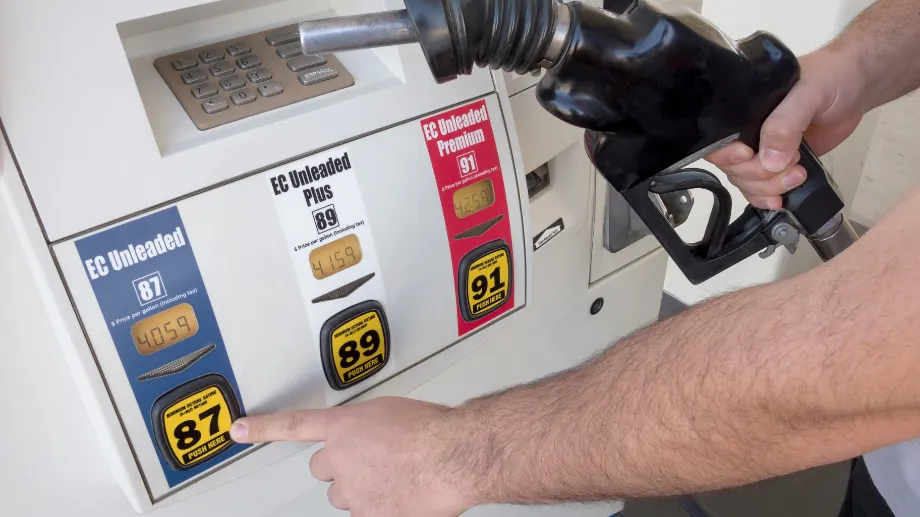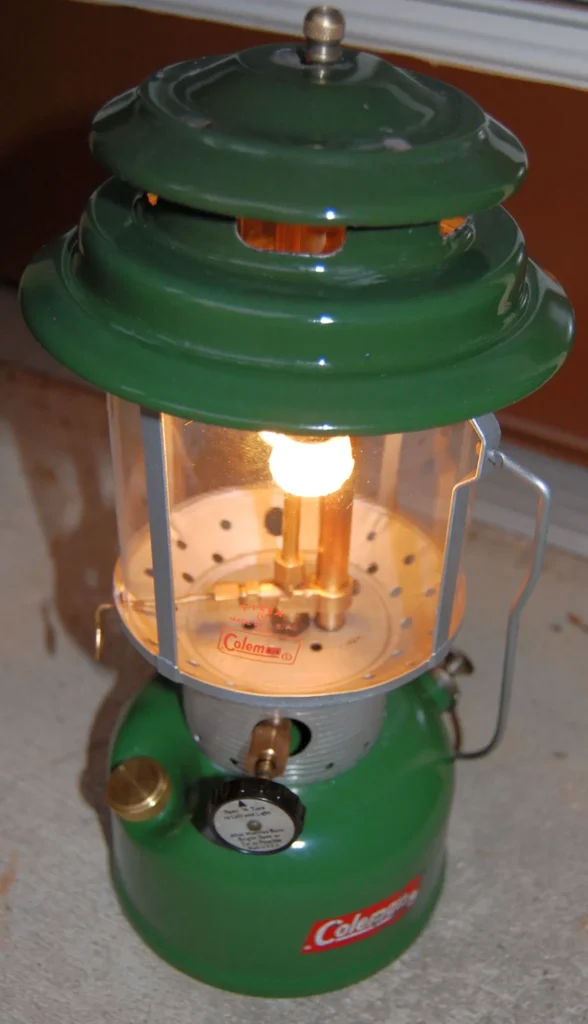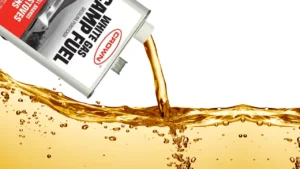I normally use Coleman fuel or white gas in my Coleman lantern because it’s one of the recommended fuel types by Coleman and I don’t have to bother getting it in a jerry can from a gas station (or siphoning it out of my car).
But you can also use gasoline in your Coleman lanterns and it will burn fine.
Unleaded gasoline is one of the recommended fuel types for Coleman dual fuel lanterns. To use it, buy the lowest octane and ethanol-free unleaded gasoline if you can so it burns cleaner and reduces the risk of corrosion.
Pour the gasoline into the fuel reservoir and use your lantern as normal in a well-ventilated space or outdoors. Clean the generator and empty the reservoir after use to prevent clogging, a sludgy mess and the parts from corroding.
Using gasoline in your Coleman lantern is slightly more complex than using Coleman fuel or white gas but you can get the most out of it by following some important steps and taking note of the recommended safety measures.
1. Buy The Lowest Octane Gasoline Available

It can be tempting to buy the cheapest E10 unleaded gas available but E10 isn't great to use in Coleman stoves or lantern.
Getting the lowest octane (non-E10) variety is best because it burns cleaner than higher octane gasoline as it has fewer additives that can clog up your lantern’s internal parts and leave residue.
Lower octane gas is usually the cheaper variety anyway so it'll come at a good price.
Thankfully, even the lowest octane unleaded gasoline is much cheaper than white gas. For example, in June 2023, 87 unleaded gasoline cost on average $3.59 per gallon while 1 gallon of Coleman gas from Walmart is around $8 and 1 gallon of Coleman Fuel is around $15 or 3-4x as much.
Crown White Gas Camp Fuel is specially blended for outdoor use of portable gasoline camping applications including gas stoves and lanterns. Manufactured with an added rust inhibitor for rust and corrosion protection. Crown White Gas Camp Fuel is carefully checked to maintain the highest level of quality for a cleaner burn and longer life.
Below are the different types of gasoline, from the lowest to highest octane:
- Regular gasoline (87 octane)
- Mid-grade gasoline (89 octane)
- Premium gasoline (91 to 94 gasoline)
- 95-octane gasoline
- E85 (flex fuel) – this gasoline usually contains ethanol
- E10-E15 gasoline (contains 10-15% ethanol respectively)
This means that if you can’t get your hands on 87-octane fuel, mid-grade fuel is the next best option followed by premium gasoline.
I recommend only buying as much gasoline as you need because its shelf life is pretty short and exposure to air can make it sludgy and ineffective.
If you’ve run out of white gas or Coleman fuel, can’t get to a gas station and your car runs on diesel, you could use diesel as a fuel alternative in your Coleman lantern. However, diesel produces a lot of dark smoke and will leave your lantern very dirty so I’d only recommend that as an absolute last resort – and even then I'd avoid it if I could as the cleanup won't be worth it.
2. Consider Ethanol-Free Gasoline
Whenever I use unleaded gasoline in my Coleman lantern I always try and buy an ethanol (or alcohol) free variety. This is because ethanol is hygroscopic and readily attracts water molecules from the air.
After using your lantern, the water molecules can linger inside the lantern and cause the metal parts to corrode. This is another reason Coleman fuel or white gas is better because it doesn’t contain any ethanol.
For more information on the differences between white gas (or Coleman fuel) and unleaded gasoline, check out this helpful article.
| Coleman Fuel / White Gas | Unleaded Gas | |
|---|---|---|
| Active Ingredients | Petroleum naphtha | Aromatic and aliphatic hydrocarbons Naphthalene Paraffin Alkene |
| Fuel Efficiency with Camping Stoves | Excellent | Good |
| Price | Relatively inexpensive | Very inexpensive |
| Alcohol, Additives and Octane Level | No alcohol or additives Very low octane level | Contains additives and 10% ethanol Octane level depends on variety |
| Availability | Wide (if you also consider generic white gas) | Extremely widely available |
| Shelf Life | 6 months once opened 7+ years if unopened | 3 to 6 months |
3. Pour The Gasoline Into The Fuel Reservoir
When you’re ready to use your lantern, pour the gasoline into the fuel reservoir (using a funnel to guide you) and close the fuel tank. After this, pressurize the fuel tank by pumping it several times.
Be sure to clean up any gasoline spills as these could ignite and cause a fire when you light the lantern.
If you have leftover gasoline, close the storage container so that it degrades at a slower rate and you can use it again.
4. Use Your Coleman Lantern As Normal

You can now light your lantern and use it as you normally would. However, since gasoline produces carbon monoxide when it is burned, use the lantern in a well-ventilated space or outdoors.
You should also avoid lighting it close to other fuel sources or an open flame as this could cause an explosion.
If you’re looking for a cleaner burning alternative to gasoline for your Coleman lantern and you don’t have white gas available, consider using denatured alcohol as lantern fuel.
Although not recommended for Coleman lanterns, it’s safer to use indoors.
5. Clean The Generator After Use
Unleaded gasoline contains additives which can leave sooty residue in and around your camping lantern.
If you don’t clean your Coleman lantern regularly (including the generator and internal components that you can get to), it may become clogged and work less effectively with time.
That said, as long as you clean your lantern after use there’s no reason you can’t use low-octane gasoline in it regularly.
A key indicator that your generator is dirty or clogged with sooty residue is if the lantern mantles are no longer burning bright.
If you're having issues check out my full guide on how to clean your Coleman generators and stoves.
The YouTube video below shows how someone is trying to check if unleaded gas will foul a Coleman lantern quicker than white gas.
Many months and tanks of fuel later and he’s still trying to detect a difference:
If you’re struggling to clean stubborn residue from your lantern, use carburetor fluid which will dissolve the stubborn residue quickly and make cleaning easy.
6. Empty The Fuel Reservoir
If you won’t be using your Coleman lantern the next evening and leaving it for an extended period, empty the reservoir and keep any leftover gasoline in a sealed container.
This is because gasoline has a very short shelf life (whereas Coleman fuel can last about 6 months when opened). Gasoline will gradually degrade and become thick and sludge-like within a short space of time, making it difficult to clean up and you wouldn’t be able to use it to power the lantern.
If you used gasoline containing ethanol, it will absorb moisture from the air and could corrode your lantern’s inner parts.
After emptying the gasoline from my Coleman lantern, I normally also leave the fuel tank open for a few hours so any remaining gasoline can evaporate and not cause a sludgy residue.
If you want to go a step further, you could give the inside of the fuel reservoir a quick swish with carburetor fluid.





